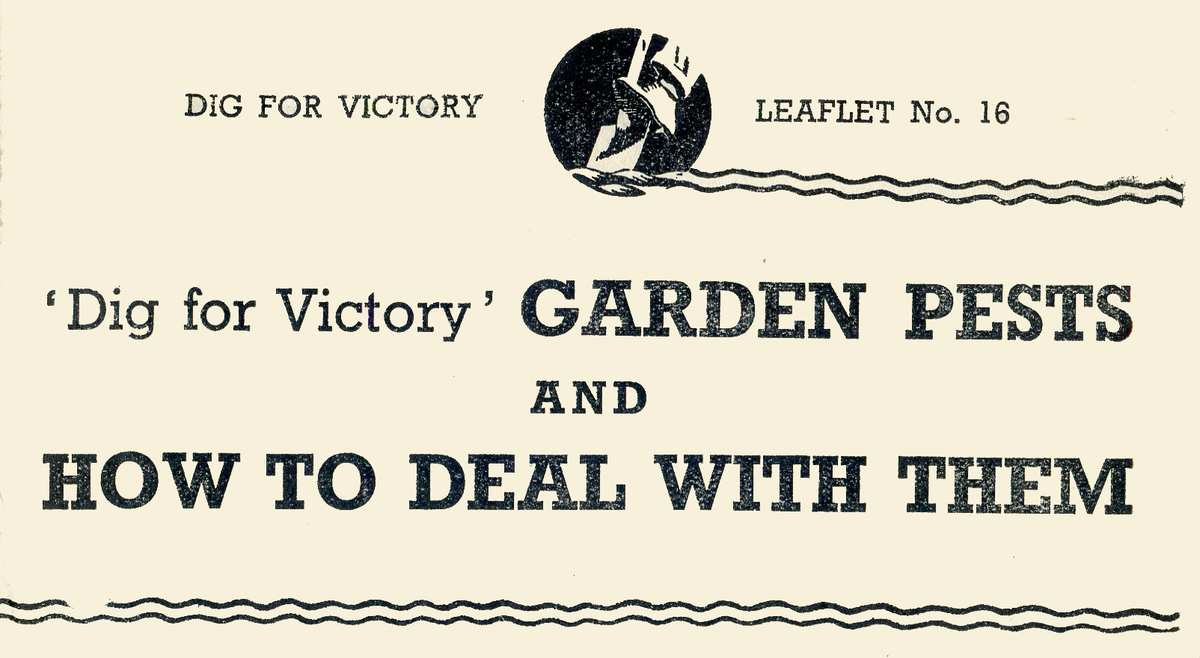 GARDEN PESTS AND HOW TO DEAL WITH THEM
GARDEN PESTS AND HOW TO DEAL WITH THEM
DIG FOR VICTORY LEAFLET No. 16 (Page 2 of 4)
Leather Jackets and Cutworms
Both these attack the underground stem of such plants as lettuces, spinach, etc., and a single leather jacket or cutworm will account for many plants.
As soon as a plant wilts, therefore, search in the soil nearby, using a pointed stick or knife to ” prod ” with until the culprit’ is found and destroyed. This measure alone is generally sufficient. (When large areas are infested a bran and Paris green bait is the remedy— see Advisory Leaflet No. 179.)
Paris Green is an extremely poisonous copper / arsenic based compound. It is green coloured and was used to kill rats in Parisian sewers, which is how it got its name. No longer approved.
Metaldehyde (” Meta “) is still used in the most popular form of slug pellets although ferrous phosphate based pellets are now available. These are just as effective and said to be more wildlife friendly and pet safe.
Slugs
Slugs can be destroyed with a mixture of metaldehyde (” Meta “) and slightly moistened bran. Small heaps should be dotted over the affected area and covered with tiles, boards, etc., to protect them from birds. Alternatively, the mixture may be broadcast very thinly—3 oz. per sq. rod.
Broad Bean Pests
Seed containing holes caused by Bean Beetles need not be rejected unless the holes are numerous.
Bean Weevils sometimes cause damage by eating the seed leaves soon after they are through, and this should be prevented by dusting with derris dust or even soot.
Black Aphis, the worst trouble of beans, appears when the plants are beginning to flower or later. If enough pods have set, pinch out the growing tips of the plants—the first part to be affected. Further treatment may not be necessary, but if the pest persists, spray with a nicotine or pyrethrum insecticide or apply a nicotine dust.
Black Aphis on other crops (for example, dwarf beans or spinach beet) should be dealt with by spraying or dusting in the same way.
Nicotine is highly poisonous and no longer available. Derris is no longer licensed for home use in the EU and naphthalene, which was the active ingredient in traditional mothballs was banned in the EU in 2008. Calomel, a mercury based fungicidal was used as a root dip when planting out brassicas into club root infected land. It is no longer licensed or available in the EU.
Pyrethrum based insecticides are still licensed and available.
Cabbages, Cauliflowers, etc.
Cabbages and cauliflowers, etc., are subject to more pests than most garden crops. As the seed germinates, the seed leaves are often eaten away by Flea Beetles. See that seedlings do not lack moisture, and give two or three treatments with nicotine or Derris dust at intervals of 3-4 days until the plants are well in the ” rough leaf”. A naphthalene dust is also effective.
The next attack to be expected is that of the Cabbage Root Fly. This causes plants of cabbage and Brussels sprouts etc., to pine and die soon after they have been planted out. To prevent this, dust the soil around the base of the plant with a 4 per cent, calomel dust, the first treatment being given as soon as the plants are set out and preferably a second a fortnight later.
As the season advances, Cabbage Caterpillars (those of White Butterflies and the Cabbage Moth) may become more and more troublesome, but serious damage can be entirely prevented by dusting the plants—at the first sign of damage—with Derris dust, repeating the treatment as soon as further young caterpillars appear.
With only a few plants, handpicking either of the eggs or the young caterpillars is quite successful, if laborious.
The last important pests to appear, and the most difficult to control, are Cabbage Aphides and Cabbage White Fly. All that can be done is to spray at the first signs of trouble with nicotine or pyrethrum wash. Nicotine dust is also useful against the aphides if the weather is warm.


